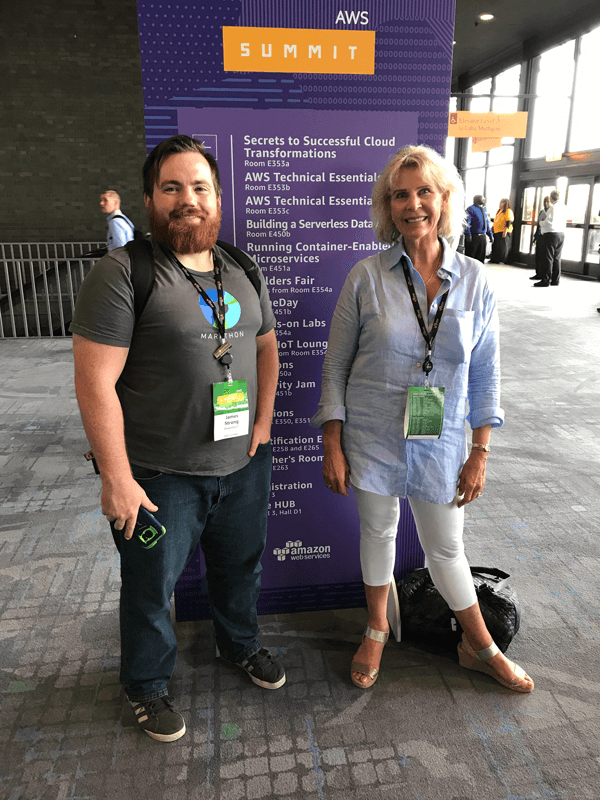
AWS Chicago Summit: What You Need to Know

I recently represented Blue Sentry Cloud at the AWS Summit in Chicago, and had one overarching thought: Just when you thought AWS had reached the apex of innovation, they up their game again.
 The pace of innovation is simply staggering at AWS, with weekly service releases flying off the shelves. Though it can be difficult to keep up, following the AWS blog is one great way to stay informed. But perhaps the most exciting way to do so is to attend these semi-annual AWS Summits, where attendees have the chance to get hands on with the new services, often facilitated by the engineers who developed them.
The pace of innovation is simply staggering at AWS, with weekly service releases flying off the shelves. Though it can be difficult to keep up, following the AWS blog is one great way to stay informed. But perhaps the most exciting way to do so is to attend these semi-annual AWS Summits, where attendees have the chance to get hands on with the new services, often facilitated by the engineers who developed them.
Another great benefit to attending summits is getting a chance to talk to other developers and users of the AWS platform — certainly, with 11,000 like-minded techies collected in one place, it creates an atmosphere that’s ripe for innovation. Often, developers will collaborate on a fix for a gap that we have observed, then shortly thereafter, we’ll receive an email announcing that AWS has released a service to do exactly what we spent 3-4 months writing. Talk about responsive!
Without further ado, let’s break down some things we learned at the AWS Chicago Summit.
Keynote Revelations
Adrian Cockcroft kicked off the 2017 Chicago AWS summit by likening AWS services to superpowers. A running theme of the summit was around the services beyond the core ones that AWS offers, to help businesses focus on what they do best and not worry about infrastructure. Innovations discussed included:
- X-Ray Vision – Using AWS Services to get unprecedented views in your data set using Athena, Hadoop, Spark, EMR and Redshift.
- Precognition – This addresses the issue of scaling that is often one of the key challenges with machine learning.
- Supersonic speed – Newer and faster instances, X1 with 2 Terabytes of memory, G3 the newest version of the GPU instance types, F1 – FPGA as a service.
- Flight – EVP of Ancestry talked about using AWS Database to help store some of the largest Customer Genomics databases in the world.
- Invisibility – Making access to data faster and debugger with DAX and X-Ray.
Managing users and policies in a single AWS account is difficult enough, but most companies maintain multiple accounts. AWS’s response to that challenge is organizations. You can create Service Control Policies that work across accounts, simplifying management processes.
Maintaining desktop applications has just gotten easier. App Stream 2.0 allows for the execution of desktop applications via browser. At the Summit session on App Stream 2.0 I learned that it supports:
- No custom installer
- Domain join support
- NICE DCV
- Supports VPC
Other innovations that are now bundled with App Stream 2.0 include: image builder, federated access via SAML 2.0, CloudWatch monitoring, Fleet Auto Scaling, Simple Network Setup, persistent storage for user files (backed by Amazon S3), support for VPC security groups, and built-in user management including web portals for users.
Released at re:Invent 2016, Shield offers DDOS protection for AWS resources. Two levels are offered — Standard and Advance. Standard is available on all Route53, CloudFront distributions and ELB’s. Advance offers a 24×7 support line to help mitigate advance threats and to foster layer 7 application traffic monitoring. You can see more of the differences here.
Patching, updating and gathering data about instances is awful — all ops guys know this. AWS EC2 System Manager tries to simplify these mundane tasks by automating it all for you! You can use predefined documents — like Windows updates — or create your own, and run them whenever needed. To manage a fleet of EC2 instances, EC2 System Manager is the way to go.
VMWare on AWS – VMWare Cloud (vmc)

The VMWare products that enterprise have grown to love and use are available in Tech Preview on the AWS platform. vSphere, vSAN, and NSX are provisioned into an AWS account for the customer to use. When enabled on your on-premise vCenter, you can vMotion VM’s into VMC running on AWS.
Other details of this innovation:
- You use your own account provisioned by VMware
- The stack is fully configured, owned, and provisioned by VMware
- You subscribe to the service
- Single tenant account just for you
- Your VPC has endpoints deployed into it to access the VMWare provided VMC.
These services continue to make moving to the AWS platform an easy, hassle-free process — from migration with VMWare Cloud, to securing it once it there using Shield. Of course, with Blue Sentry Cloud’s help, the process can go even smoother.
AWS Summits are a great way to stay informed on the latest AWS services offerings, meet with Vendors and network with other IT professionals using the platform. You can find out when and where they are happening here. I highly recommend attending them — and the best part is that they are free! Let us know your experience at a summit @bluesentryit or @strongjz.
